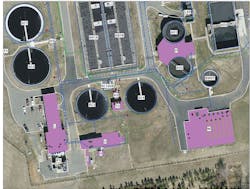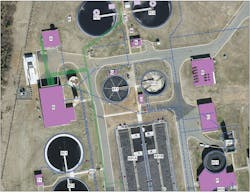About the author:
Michael Cameron is GIS program manager for WK Dickson. Cameron can be reached at [email protected] or 803.786.4261.
Asset management has become a buzzword in the water and wastewater industry over the last decade. As many of communities continue to grow, society has acknowledged that its infrastructure has not been adequately maintained. However, the remedy to this situation brings many questions. What infrastructure do we have? What condition is it in? How much will it cost to repair? Would we be better off replacing it with something else? What are the financial and operational impacts of multiple repair and replacement scenarios?
For many water and wastewater managers, the first asset management steps fixate on the linear assets, namely the mains, laterals, manholes, valves, tanks and other infrastructure that make up the collection and distribution systems. These are vital components of the utility. More frequently developing an asset management program is required as part of addressing Administrative Orders of Consent from the U.S. EPA. However, the conversation never goes without asking the question, “What about the plant?”
Managing vertical assets is just as important as managing the linear assets. Fortunately, there are excellent tools and proven tactics to make the job easier.
A Personal Experience
I can still recall the first time I toured a water treatment plant. Pipe, valves, pumps, storage tanks, and myriad other equipment all worked in sequence to produce a low hum in addition to the drinking water for a metropolitan community. Monitors and control panels filled a small room in the single-story brick building adjacent to the flocculators. That room reminded me of the bridge of a ship. At the helm of this ship stood Jerry.
As plant manager, Jerry knew every detail of the plant’s goings-on and where it had been 25 years prior. He had witnessed two plant expansions, seen nearly all the current equipment installed, and witnessed repairs of many of those pieces of equipment, sometimes more than once. As I listened to Jerry describe his operational procedures, it was clear he had honed a method to operate the plant by knowing everything about the plant at any moment. It also was clear that a facility such as his water treatment plant is intricate and complex.
I have met a lot of water treatment plant managers since then, and each of them know the intricacies of their facilities so they can make decisions quickly and effectively. Almost none of them think of themselves as asset managers, yet they all agree that is exactly what they do.
If I went back 20 years and sat down with Jerry at that water treatment plant and asked him the asset management questions I listed above, I am confident he would have been able to answer some of them.
His supporting data for his decisions would have been clipboards with inspection sheets, file folders of repair orders, and some of it would be pulled from the grey matter between his ears, affectionately referred to as “institutional knowledge.” When I ask those questions today of many plant operators, I get similar results, and that is not a viable solution for the future.
Questioning Asset Inventory
How can these plant managers change? How can they develop an asset management program that includes vertical assets? The first step in building any asset management program is to understand what goes into an asset management program. This comes down to several key components and questions:
• Asset Inventory. What assets do we have, where are they located, what do we know about them?
• Level of Service. What do we expect our assets to be capable of doing? Do we want to provide the uninterrupted distribution of 10 million gal of water per day? How quickly do we want to respond to problems that arise?
• Operations and Maintenance Strategies. What technology or processes are in place to collect and manage information about the operations of the facility? Is there a computerized maintenance management system (CMMS) in use? If so, how is it being used?
• Financial Parameters. What sources of funding currently exist? What corrective actions are necessary to meet service goals, and is there adequate funding? What options exist to maximize
available resources?
Gap Analysis With GIS
These are all basic components of the asset management program, but each component can become quite complex. Often, the second step in developing an asset management program is to conduct a gap analysis. Organizations use gap analysis to understand the status of the components in it asset management program. The analysis helps determine necessary changes to reach the organization’s established goals.
Asset inventory is a portion of an asset management program that geographic information systems (GIS) increasingly manage and solve. Many utilities now have GIS that uses points, lines and polygons to represent the individual assets in the field. In the case of vertical assets such as treatment plants and pumping stations, the asset inventory inherently is more complicated.
In these facilities, not only are more assets in close proximity to one another, but also those assets often are arranged vertically and horizontally. This means the two-dimensional GIS now needs to represent a third dimension. For those involved with GIS, 3D representation of assets has been a challenge.
Fortunately, combining technologies such as building information modeling (BIM) with GIS can address these challenges. GIS software solutions such as ESRI’s ArcGIS Indoors could help on this front; however, the implementation is still in its infancy. One of the great advantages of GIS in managing vertical assets is the ability to utilize relational databases.
Real World Application
On two recent projects, the assets within the water and wastewater treatment plants were built into a customized geodatabase schema. The schema was developed to manage assets according to the process in which they were used. For example, the influent pumping process is represented as a feature dataset. The individual assets within the influent pumping process are represented as feature classes. Many of the feature classes are related topics, such as pumps and motors.
In this set up, if a motor is replaced but the pump stays in operation, and plant managers can track the attributes of each asset, as well as previous operations and maintenance (O&M) data from the CMMS.
Managing vertical asset inventory data through the GIS, with a live connection to CMMS gives maximum flexibility to capture O&M procedures and condition assessments, and support decision-making processes such as capital planning, budgeting and operational analysis. For the two clients in these management projects, building a 3D GIS representation of their respecitve plants was not a practical step during the initial phase. However, the ability to incorporate a 3D representation of the plants is an advantage of conducting the asset inventory through GIS.
Essentially, converting assets from hard-copy record drawings, organizing a geodatabase schema, and building the connectivity throughout the plant’s processes is complete. The remaining effort lies in assigning an elevation to the established horizontal location of each asset. This likely will be accomplished through a combination of light detection and a ranging and conventional survey.
Developing an asset management program for vertical assets also includes addressing current O&M procedures in addition to evaluating under which financial parameters the program must operate. The ability to understand the condition of an asset, how that condition is impacted, and the consequences of that condition are the most critical and overarching aspects of this approach.
Asset criticality is defined as the evaluation of an individual asset’s likelihood of failure combined with the consequence of failure. In the realm of vertical assets, it also becomes more critical to understand the asset’s mode of failure. For example, a pump may fail through the loss of the drive motor, a compromised impeller or foreign debris damage. The mode of failure impacts the consequence of failure in regard to downtime, part availability and labor necessary to complete the repair.
Evaluating the criticality of each individual asset within the plant is not only made possible by managing the asset inventory data in relational databases through the GIS and CMMS, but also the efficiency of the process significantly is increased.
In cases where I have worked with clients to develop these processes and tools to assess criticality and evaluate mitigation scenarios, the amount of time necessary to complete the gap analysis typically is measured in minutes rather than days.
Managing vertical asset information is a vital part of an overall asset management program for every utility. Past challenges are not going away, but fortunately there are tools and processes available to make the challenges achievable. The key is understanding what tools are needed and how best to apply them.

